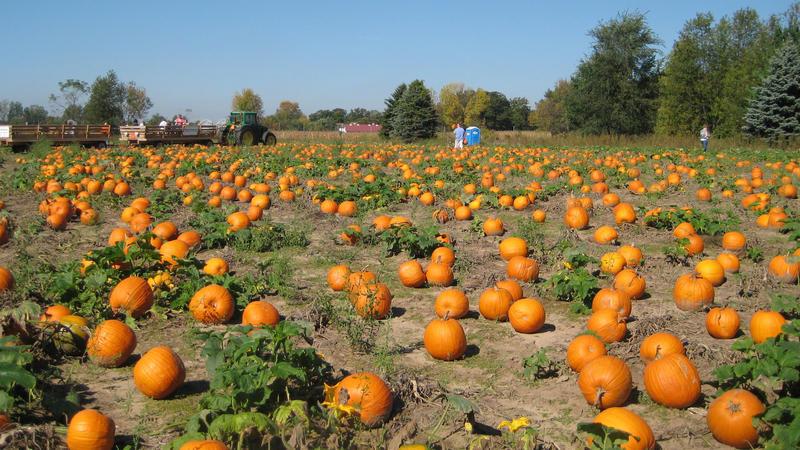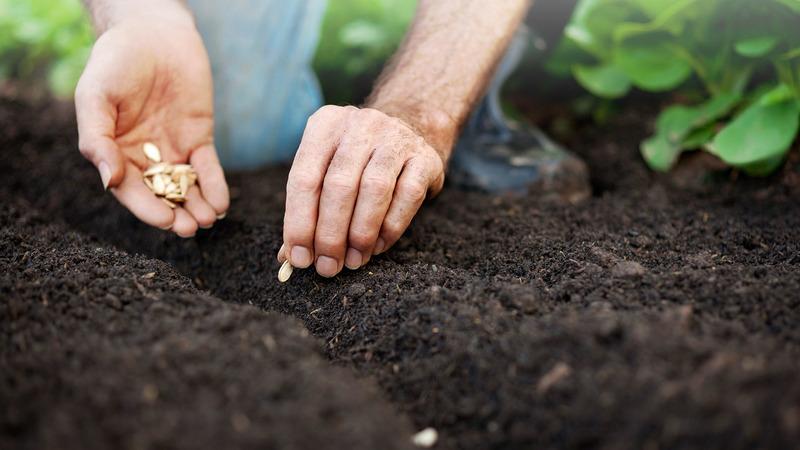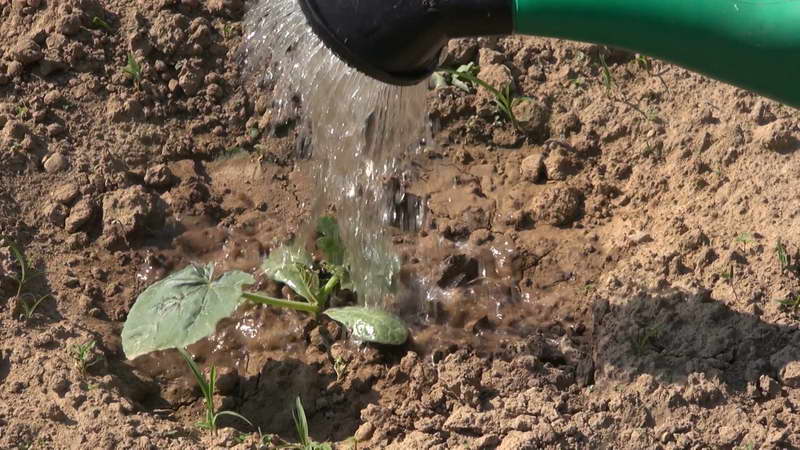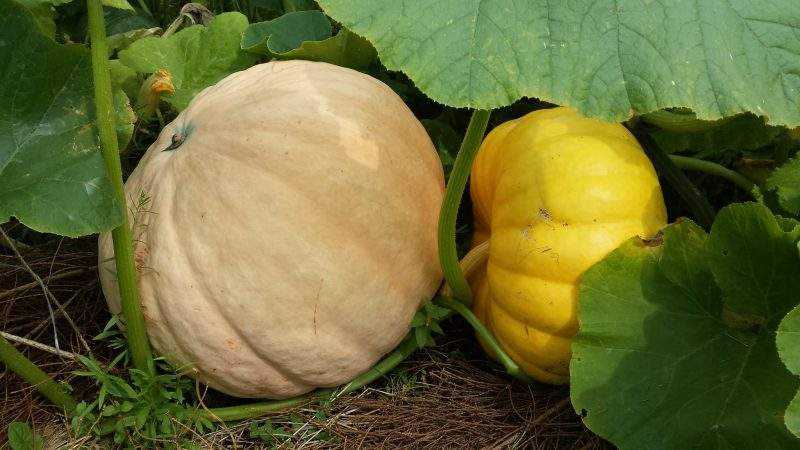How to grow a large pumpkin in the open field in the country: step-by-step instructions and secrets of experienced agronomists
Large fruits different varieties of pumpkin, ripening in the beds, will decorate even the most ordinary suburban area. The world's largest normally grown vegetable has exceeded 1,000 kg. The large size of the fruit does not in any way affect their storage, taste and useful properties.
Often we do not pay attention to what is growing under our feet. Pumpkin is known to promote weight loss and heal vascular pathologies. Read all about growing a large pumpkin below.
The content of the article
Variety selection
How to grow a large pumpkin in the country in the open field? To do this, first of all, you should correctly pick a variety... When choosing a large pumpkin variety, people often opt for such types as Big Max, Atlant or Titan. With proper care, some fruits can reach 150 kg.
Features:
- Big Max gives ripe fruits up to 40 kg. The pulp is sweet, the peel is light orange, quite dense, slightly bumpy. Store at room temperature until spring.
- Atlant Is a late-ripening variety. Ripens in 110-130 days from germination. Better to grow in seedlings. The weight of a ripe fruit is from 20 to 50 kg. The pulp is juicy and soft, orange in color. The fruit has a segmented surface.
- Titanium... Some summer residents managed to grow the fruits of this pumpkin weighing 150 kg. For a vegetable to reach this size, it must be grown on fertile soil, leaving one fruit on the plant. To obtain a large fruit, the variety is grown through seedlings.

The process of growing large pumpkin
To plant seeds in the ground, it is important to wait until the soil warms up to + 10-12 ° C. The temperature is checked in 10 cm of the topsoil. If the condition is met, we proceed to further work.
Seed preparation
To grow large pumpkin, it is important to choose the right seeds and prepare them for sowing. This procedure takes a little time, but in the future it has a positive effect on the size and quality of the fruit.
For a good harvest, choose the heaviest seeds. It is correct to select them not by size, but by weight. For friendly shoots, before planting, the seeds are heated for 2 hours at a temperature of 50-60 ° C. Then, to prevent fungal diseases, they are kept in a weak (1%) solution of potassium permanganate for 12 hours.
In order for the sprout to break through the hard peel of the seed, use an ash solution, for the preparation of which you will need to stir 2 tbsp in 1 liter of boiling water. l. wood ash. Then the gauze folded in several layers is moistened with a solution and the seeds are wrapped in it for 12 hours.
After the performed procedures, the seeds are ready for germination at home. Some of them are sown directly into the ground.

Soil preparation
After harvesting, the soil is loosened, then dug to a depth of 25-30 cm.In the spring, the site is loosened twice - the first time to a depth of 15 cm, the second time before sowing by about 7 cm.
After the previous culture, it is recommended to loosen the soil together with the introduction of fertilizers - humus or manure (5 kg per 1 sq. M), also 10-20 g of potassium salt and 25-30 g of superphosphate.
During the autumn digging, more manure is introduced, but so that nitrates do not accumulate in the fruits, it is better to replace the manure with peat compost (7 kg per 1 sq. M). Acidic soils are limy. So that nitrogen is not lost, after digging, lime is scattered over the soil surface.
If you simultaneously apply potash and phosphate fertilizers, the yield will definitely increase.Potash fertilizers increase resistance to diseases, and phosphorus fertilizers contribute to the development of the root system and ripening of fruits.
Planting with seeds and seedlings
To begin with, mark the landing holes on the garden bed. Pour 2-3 liters of water heated to 50 ° C into each one, then plant 2-3 seeds at a depth of 4 cm into loamy soil... On light soils, we increase it by 3 cm, placing the seeds in the form of a triangle with equidistant sides from the center of the hole. Sprinkle with earth and mulch with humus or compost.
We leave a distance of up to two meters between the rows, and one meter between the holes, we plant in a checkerboard pattern. If the nights are cold, cover the bed with a film. With the emergence of seedlings (after 7 days), we remove the covering material. When two true leaves grow, we thin out, leaving two shoots in the hole.
On a note. When thinning, do not pull out the seedling, but cut it off at ground level to avoid disturbing the root system of neighboring plants.
Pumpkin seedlings are planted at a soil temperature of at least 10 ° C. It is determined using any household thermometer by placing it in the ground for 10 minutes. To preserve the soil heat, the seedlings are covered with a black film, and just before planting, each hole is spilled with hot water in the amount of 2-3 liters.

Pumpkin care
Pinching the pumpkin is performed when fruits 10 cm in diameter appear on the lashes. This is done so that 4-6 leaves remain above each fruit.
To increase the amount of harvest, the formation of bushes is carried out. 2 pumpkins are left on the main whip, and one on the side ones.
Before the first flowers appear, the pumpkin is watered abundantly with warm water, previously loosening the soil around the plants. When it blooms, the intensity of watering is reduced so that the fruits are formed correctly.
You should also do additional pollination - this is done with a soft brush or by gentle contact of flowers.
Top dressing is applied 1 time in 8-10 days, alternating organic fertilizers with mineral fertilizers. If there is prolonged cloudy weather outside, the leaves are sprayed with a urea solution (1 tablespoon per 10 liters of water). During the period of intensive ripening, the bushes are sprinkled with wood ash (1 glass per plant).
Cardboard is placed under the pumpkin so that there is no contact with damp earth. This will prevent the pumpkin from rotting in the garden.

Diseases and pests
Pumpkin bacteriosis can occur due to waterlogged soil combined with sharp temperature changes. This disease manifests itself as small brown sores on the fruit.
At the first sign, dilute 10 g of copper sulfate and 10 g of lime in 10 liters of water. Spray well the pumpkin stalks and leaves. When some leaves and fruits are affected, they are cut off and burned away from the site.
White rot is formed from low temperature and high humidity... Most often it appears in a thickened planting. The disease manifests itself on the fruit with white spots, which turn black over time. For prophylaxis, treat the seedlings with a Bordeaux mixture, and then you will not be in danger of fighting them.
Root rot occurs as a result of watering with cold, not settled water. In this case, the lower leaves turn yellow, and the stems acquire a brown color. The disease can destroy the entire plant. When the first signs of the disease appear, we remove the top layer of soil, at the roots of the neck and add fresh soil, sand, sawdust or peat (for the growth of new roots). We process the stems, shoots and leaves with chalk, lime, ash or crushed coal. Spray the root collar with a 1% solution of "Fundazol".
Powdery mildew appears due to rare watering... Sometimes it is formed from excessive fertilizing with nitrogen fertilizer. This disease covers the leaves with a white coating, then they dry out and fall off. As soon as you notice the first signs, immediately remove the affected areas and burn them, and spray the plants with colloidal sulfur (20 g per 10 L of water).
The most dangerous pests are melon aphids and spider mites. To exclude aphid infestation, weeds should be promptly removed. If the aphid has already overtaken, we spray with soapy water (200 g of grated soap per 10 liters of water) or 10% "Karbofos" in a proportion of 60 g per 10 liters of water. Spraying with onion infusion (200 g of husk per 10 l of water) or a 20% solution of "Chloroethanol" (20 g per 10 l of water) will help to eradicate the spider mite.
On a note. The next time, you can grow pumpkin in the same place no earlier than after 7 years.
Harvesting
Full ripening of the pumpkin is recognized by the stalk. It becomes hard and dry. The leaves and whips will begin to turn yellow and die off - this suggests that the pumpkins have taken all the nutrients from the plant and it is time to collect them.
The collection period for the calendar depends on the characteristics of each variety and ranges from late August to mid-October.
The pumpkin is carefully cut with a knife or pruner. Then the fruits are cleaned of dirt and dried. It is better to immediately inspect each fruit for scratches and mechanical damage. If they are found, the pumpkin will not last long.
The crop is stored in a cool dry place out of direct sunlight for one to six months.

Secrets of experienced agronomists
Masters of their craft believe that it is possible to grow a large pumpkin without any nitrates. The main thing is to know some secrets:
- A vegetable needs enough space to grow... One large pumpkin will need 1.5 square meters. m.
- Do not let the bed be in the shade. It is very important that the growing vegetable has enough light.
- Cover the knots with moist soil to stimulate root formation. For the formation of a large fruit, a plant of this species needs a more powerful root system than other varieties.
- When ovaries begin to form on the bushes, measure them daily. This measure is necessary to determine the largest fruit. As soon as you find the largest ovary, leave it, and remove the rest. Otherwise, it will not be possible to grow a large pumpkin: the bush, receiving nutrients and moisture, will evenly distribute them to all growing fruits.
- We form bushes according to the principle of ate... One stem should remain on the plants. Lateral processes, to facilitate care, are recommended to be placed at right angles to the main one. As soon as the second-order stems grow a couple of centimeters, carefully remove them. The main stem will continue to grow after the inflorescence has emerged. As soon as it grows to 4-6 meters in length, it must be pinched.
- When the vegetable is large, move it around from time to time to prevent the fruit from crushing the main stem. The pumpkin stalk is located at an acute angle in relation to the "mother's umbilical cord". The pumpkin will grow over time, and if you do not change its position, then it will simply crush the stem. Daily movement of the vegetable a few centimeters is carried out until the stalk is located at a right angle from the main stem.
- After planting seedlings in open ground, it is not necessary to water it for the first 3 weeks... After this period, set a schedule for regular application of moisture to the soil. For 1 sq. m beds per day will require about 6-7 liters of water. In this case, moisture is applied to the entire area of the pumpkin patch, regardless of the location of the holes. The powerful root system of the pumpkin occupies not only the area of the hole, but also the territory of the entire garden. To ensure that the plants have enough moisture, do not spare water.
If the soil needs feeding, then it is applied three times per season. The first time is fertilized before the pumpkin blooms. Prepare yourself in the following proportions:
- potassium - one part;
- nitrogen - one part;
- phosphorus - three parts.
The second time, fertilizer is applied after the appearance of the ovaries. It is prepared as follows:
- phosphorus - one part;
- potassium - three parts;
- nitrogen - three parts.
The third feeding is done after removing all the ovaries on the bush, except for the potential large fruit. Fertilizer preparation:
- potassium - four parts;
- nitrogen - two parts;
- phosphorus is one part.
In order not to burn the roots, the fertilizer is diluted with water with the calculation of 200 g of the finished mixture per bucket of water. Each well requires up to 5 liters of nutrient fluid.
Read also:
An exotic vegetable with an unusual taste and name - "Pink Banana" pumpkin.
Medicinal properties of wax gourd and features of its cultivation.
Conclusion
Huge pumpkins can make your garden famous and will be used not only in dishes on the table, but also as decorations for the fall holidays. To get big fruits, experienced agronomists recommend using the seedling method. Growing pumpkin is not difficult, it is only important to have a great desire and make a little effort.